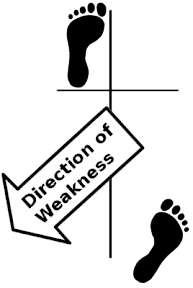This article was originally posted by me at okiblog.com. I highly recommend heading over there if you are interested in reading some great material about Okinawan Karate.
The term "Kuzushi" tends to confuse a few students at our club. I hear a few people talk about how you have to "break your opponents kuzushi before you can complete the technique.". Let's get the definition of kuzushi out of the way first, shall we?
Kuzushi - the point at which the stability of the stance is compromised, where the centre of balance is pushed to the point that requires movement in order to regain proper balance.
There are two points one should focus on in order to gain kuzushi on an opponent; the hips and the shoulders. The easiest way to disrupt these points is to crowd your opponent. Another method is to drive your opponent into the direction of least stability. I'm going to use some techniques from Juniko as examples.
Crowding
The key to gaining kuzushi when crowding your opponent is to use your stance and technique against theirs. In Juniko, the eighth technique is the perfect example of this, as shown below beginning at 0:47.
- Attacker stands in hidari seisan-dachi, chudan kamae.
- Attacker performs migi oi-zuki.
- Defender steps back into hidari seisan-dachi and blocks with a heishu-uke.
- Defender steps forward into migi seisan-dachi, wraps his (or her) left arm around the punching arm of the attacker and shoots right hand past attackers neck over their left shoulder. At this point, the attacker and defender should be hip to hip. When stepping into seisan-dachi, the defender's right thigh pushes against the right thigh of the attacker, twisting their hips and pushing their hips to their left. Depending on the height of the people involved, this could even lead to the attackers right foot leaving the ground. This is the point of kuzushi. The attackers stance has been compromised, and unless they move, they are unable to maintain stability.
- Defender transitions their back foot into shiko-dachi and guides the attacker over their front leg for the take-down. Since the defender has gained kuzushi, there should be no effort required to take the attacker down.
 |
| Figure 1: Seisan-Dachi |
The other method of gaining kuzushi is to drive your opponent in the direction of least stability. Each stance has it's strong points and weak points, and it is of major importance that the student understands each. For instance, seisan-dachi (Figure 1) has strong stability forewards and backwards, as well as to each side. The weak point is at 45 degrees to the left or right (depending on which leg is forward) behind the opponent.
 |
| Figure 2: Shiko-Dachi |
With a shiko-dachi (Figure 2), the stance is very strong along the direction of the stance, but the weak points are at the front or back of the person.
Performing the stances with the correct weight distribution, correct angle of the knees, correct alignment of the feet, should reduce the size of the weak points in the stances, but will not eliminate them.
The finer details of stances are a whole other topic. I'll cover them at some time in the near future.
Knowing this, let's take a look at Juniko technique number twelve (above video, at 1:18).
- Attacker stands in hidari seisan-dachi, chudan kamae.
- Attacker performs migi oi-zuki.
- Defender steps back into hidari kosa-dachi and blocks with a migi heishu-uke.
- Defender grabs the right wrist of the attacker with their right hand, steps forward into migi seisan-dachi and drives the attacker's wrist back behind them while applying torque to the wrist. This drives the attacker's elbow up and twists their shoulders towards the weak point in their stance. Notice the front foot of the attacker in the video. This is the point of kuzushi. The attackers stance has been compromised, and once again, unless they move, they are unable to maintain stability.
- Defender transitions their back foot into shiko-dachi and pushes the attacker's hand down to the floor behind the attacker's back, which is the weakest point of the stance. The attacker is pulled over the defender's front leg.
Juniko is filled with examples of gaining kuzushi on an opponent, as are most of the goshin-jitsu techniques learned in Chito-ryu. Performing these techniques correctly takes a lot of practice. Best method is to perform them slow ... a lot. After a while, the pace can be increases and eventually perform them at full speed.